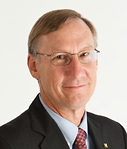Stephen R. Forrest, U-M’s vice president for research since 2006, will return to the research and teaching he loves when he rejoins the College of Engineering faculty in January.
Even while serving as vice president for research at U-M, Forrest has remained an active researcher. He is widely recognized as one of the world’s leading researchers in optoelectronic integrated circuits and organic semiconductors.
During the Sept. 19 Board of Regents meeting, President Mary Sue Coleman praised Forrest’s commitment to innovation and collaboration among university researchers and said she would soon recommend an interim leader for the university’s research enterprise.

Coleman said she would appoint interim leadership for OVPR “to ensure a smooth organizational transition” and to allow the next U-M president to conduct a search for the Forrest’s replacement.
In an email message to colleagues, Forrest said, “It has been a genuine pleasure and honor to serve this institution as vice president, and to work with President Coleman who, along with the regents, has provided thoughtful and supportive leadership that has embraced the importance of research to the mission of this great university, and its contribution to the health and vitality of our nation’s economy.”
Forrest is the William Gould Dow Collegiate Professor of Electrical Engineering and Computer Science. He also is a professor of materials science and engineering and a professor of physics.
During his tenure as vice president, the university has dramatically grown and diversified its research portfolio and funding, even as total federal research funding has declined. During the same meeting that his return to the faculty was announced, Forrest noted that U-M had again set a record for the total research volume in fiscal year 2013: $1.3 billion, up 4.3 percent from the previous year.
Among his many accomplishments as vice president, Forrest has:
• Supported the development of the U-M Energy Institute, which draws together energy research from across the entire campus.
• Launched the new Mobility Transformation Center to work with government and industry partners to develop a system of connected vehicles and infrastructure on the streets of southeastern Michigan.
• Supported social science research by establishing Society 2030 and the Social Science Initiative.
• Led expansion of international research cooperation by initiating partnerships with Shanghai Jiao Tong University in China and Ben Gurion University in Israel.
• Established Advanced Research Computing as a unit that supports the use and expansion of computing resources that can enable new approaches to research in many fields.
• Committed the university to fulfilling the letter and intent of the Native American Graves Protection and Repatriation Act (NAGPRA), which requires institutions that receive federal funding to transfer specified human remains and culturally affiliated objects to lineal descendants who have requested them and have a legal right to them.
He also has supported the university’s involvement in local and regional economic development efforts by assisting startup companies based on U-M technology, creating the Business Engagement Center to strengthen research and philanthropic ties to industry and by serving as chairman of Ann Arbor SPARK, the community’s economic development agency, and on the board of the Michigan Economic Development Corp.

